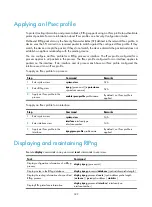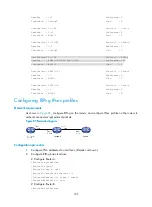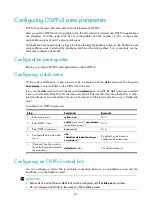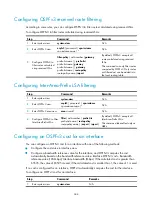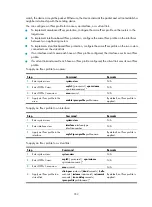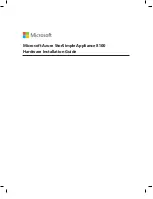
337
[RouterB-ipsec-profile-profile001-manual] sa string-key outbound esp simple abc
[RouterB-ipsec-profile-profile001-manual] quit
# On Router C, create an IPsec transform set named
protrf1
, and set the encapsulation mode to
transport mode, the security protocol to ESP, the encryption algorithm to 3DES, and authentication
algorithm to MD5. Create an IPsec profile named
profile001
, specify the manual mode for it,
reference IPsec transform set
protrf1
, and set the SPIs of the inbound and outbound SAs to
256
and
the keys for the inbound and outbound SAs using ESP to
abc
.
[RouterC] ipsec transform-set protrf1
[RouterC-ipsec-transform-set-protrf1] esp encryption-algorithm 3des-cbc
[RouterC-ipsec-transform-set-protrf1] esp authentication-algorithm md5
[RouterC-ipsec-transform-set-protrf1] encapsulation-mode transport
[RouterC-ipsec-transform-set-protrf1] quit
[RouterC] ipsec profile profile001 manual
[RouterC-ipsec-profile-profile001-manual] transform-set protrf1
[RouterC-ipsec-profile-profile001-manual] sa spi inbound esp 256
[RouterC-ipsec-profile-profile001-manual] sa spi outbound esp 256
[RouterC-ipsec-profile-profile001-manual] sa string-key inbound esp simple abc
[RouterC-ipsec-profile-profile001-manual] sa string-key outbound esp simple abc
[RouterC-ipsec-profile-profile001-manual] quit
4.
Apply the IPsec profiles to the RIPng process:
# Configure Router A.
[RouterA] ripng 1
[RouterA-ripng-1] enable ipsec-profile profile001
[RouterA-ripng-1] quit
# Configure Router B.
[RouterB] ripng 1
[RouterB-ripng-1] enable ipsec-profile profile001
[RouterB-ripng-1] quit
# Configure Router C.
[RouterC] ripng 1
[RouterC-ripng-1] enable ipsec-profile profile001
[RouterC-ripng-1] quit
Verifying the configuration
RIPng packets between Routers A, B, and C are protected by IPsec.







